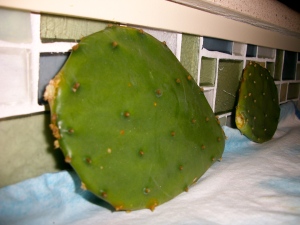 Winter time in the Outer Banks of NC does not infer notions of life, fertility or growth. Little is to be had in the way of local food, or even organic food, or even food not decked out to the hilt with packaging in forms like cellophane (garlic bulbs, really?) and styrofoam egg cartons. Fish is about all the local economy has to rely on during the bare stretch of windy, cold winter days on the coast. A complete turnaround from the tourist-ridden days of summer and fall when all the pubs, restaurants, tackle shops, gift stores and ice cream parlors are maxed out with business and the cash is flowing. But what is there to depend on during the winter?
Winter time in the Outer Banks of NC does not infer notions of life, fertility or growth. Little is to be had in the way of local food, or even organic food, or even food not decked out to the hilt with packaging in forms like cellophane (garlic bulbs, really?) and styrofoam egg cartons. Fish is about all the local economy has to rely on during the bare stretch of windy, cold winter days on the coast. A complete turnaround from the tourist-ridden days of summer and fall when all the pubs, restaurants, tackle shops, gift stores and ice cream parlors are maxed out with business and the cash is flowing. But what is there to depend on during the winter?
One local, untapped resource would be Ocracoke Island’s prickly pear cactus.
Oputunia humifosa, being the most widely adapted species along the east coast from New England on down, is a prolific plant, that needs very little attention and provides a dependable crop. Though as a cactus it naturally loves dry climates, the drainage offered by the sandy soil conditions on the Outer Banks makes for a hospitable situation. It grows wild in yards and among trees and brambles on Ocracoke Island and is useful as both vegetable (pads, or nopales) and fruit (tunas).
The prickly pear genus is known for having 2 types of pricklies: visible spines like most other cacti, and ‘glochids’ which are smaller, hair-like spikes that are hard to see and just as hard to remove from skin. This is why it’s a good idea to use gloves or tongs when cutting or dealing with these guys.
We have a plant in some of the brambles in our side yard on the Pamlico Sound side of the island; we wanted to propagate it so more plants could take up residency on our lot. First I took tongs and a sharp knife and sliced at the joint between a couple of pads, then I brought them inside with me to let them sit for about a week so that a callous would form over the fresh cuts; not to seal over, just to dry out so rot wouldn’t occur when they’re planted.
And finally, planting them in about an inch of well drained, sandy soil and NOT WATERING is all that’s left to do to get the new cactus plants established. Just like most other plants, propagation and cuttings are best done in the winter and early spring, when plant juices and saps are dormant and less likely to cause rot or other damage to the plant when being sliced and moved about. Only after roots have sprouted and become established would you want to do any watering.
So, in about 3 years we’ll have a few more cactus plants from which to harvest (you don’t want to harvest until 3 or 4 pads of good size – about 4″ across at least – have grown), when we’ll be able to harvest the ‘tunas’ for fruit dishes (they’re supposed to taste like watermelons and have great smoothie potential) and the pads for veggie stir fries (they’re said to have a flavor like green beans.) Both are chock-full of soluble fiber, making them desirable for blood sugar control and filling up an appetite. Cooking makes for easy spine-removal, and peeling the skins off is always a good idea.
Prickly pear muffins? Marmalade? Island smoothies? Prickly pad casserole? Only time will tell……..



Very nice!
I love your creativity with food. You see a plant and get inspired – and inspire the rest of us!
Your blog is amazing! I want to try this so bad.
Your blog is one of my favorite new things :) I can’t wait to see what you do with these beautiful succulents. What about a prickly pear salsa or sauce served over fish?
Hi,
I am making a educational film about cacti and how to propagate Opuntia and I would dearly love to talk to you about using one of your pictures in the film.
It is being made to go online of a well known botanical gardens in the UK. If you are able to help me I would be very grateful.
Thanks,
Lucy